tailgate SAAB 9-5 2003 Owners Manual
[x] Cancel search | Manufacturer: SAAB, Model Year: 2003, Model line: 9-5, Model: SAAB 9-5 2003Pages: 288, PDF Size: 16.78 MB
Page 4 of 288
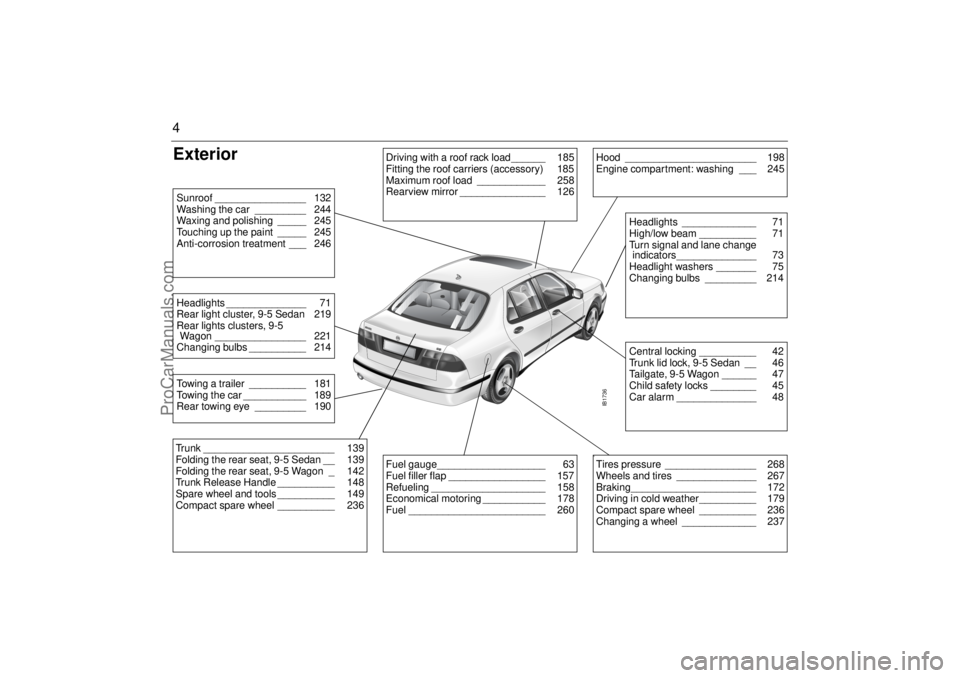
4Exterior
IB1736
Driving with a roof rack load______ 185
Fitting the roof carriers (accessory) 185
Maximum roof load ____________ 258
Rearview mirror _______________ 126
Hood _______________________ 198
Engine compartment: washing ___ 245
Central locking __________ 42
Trunk lid lock, 9-5 Sedan __ 46
Tailgate, 9-5 Wagon ______ 47
Child safety locks ________ 45
Car alarm ______________ 48Headlights _____________ 71
High/low beam __________ 71
Turn signal and lane change
indicators______________ 73
Headlight washers _______ 75
Changing bulbs _________ 214
Fuel gauge___________________ 63
Fuel filler flap _________________ 157
Refueling ____________________ 158
Economical motoring ___________ 178
Fuel ________________________ 260
b Tires pressure ________________ 268
Wheels and tires ______________ 267
Braking______________________ 172
Driving in cold weather__________ 179
Compact spare wheel __________ 236
Changing a wheel _____________ 237
Trunk _______________________ 139
Folding the rear seat, 9-5 Sedan __ 139
Folding the rear seat, 9-5 Wagon _ 142
Trunk Release Handle __________ 148
Spare wheel and tools __________ 149
Compact spare wheel __________ 236Towing a trailer __________ 181
Towing the car ___________ 189
Rear towing eye _________ 190Headlights ______________ 71
Rear light cluster, 9-5 Sedan 219
Rear lights clusters, 9-5
Wagon ________________ 221
Changing bulbs __________ 214Sunroof ________________ 132
Washing the car _________ 244
Waxing and polishing _____ 245
Touching up the paint _____ 245
Anti-corrosion treatment ___ 246
ProCarManuals.com
Page 42 of 288

42 SecurityDoorsDoor handlesPull the handle to open the door.
If the door is stuck (e.g. if frozen), hold the
handle from above to secure a better grip.
Central locking
Key / Remote control The key unit consists of a mechanical key
with integrated remote control.
The mechanical key is used for manual
locking and unlocking.
The remote control is used for remote lock-
ing and unlocking.
The key fits all the car’s locks.
The key supplied with the car has a code
number on a black plastic tag that needs to
be quoted for ordering additional keys. You
should therefore make a careful note of the
number.
The key contains a unique electronic code
for your car. When the key is inserted in the
ignition, the code is checked. If it matches,
the car can be started. Two keys are supplied with the car. It is pos-
sible to have up to four at one time that are
coded for your car. If one is lost, contact
your authorized Saab dealer to obtain a
replacement.
NOTE: For this reason, we strongly advise
you to take two keys with you on long jour-
neys and to keep them separate. If all keys
are lost, it will be necessary to replace costly
electronic components as well as the keys.
This loss and replacement cost is not cov-
ered by the new car warranty.
If an additional key is to be added, all of the
original keys must be brought to the dealer
so that the control module can ”learn” to rec-
ognize the new components.
WARNING
Leaving children or pets unattended in a
locked car is dangerous. It is also danger-
ous to leave children in a vehicle with the
ignition key. A child or others could be
badly injured or even killed.
Key / Remote control1To lock
2 To unlock
3 Opening the trunk (9-5 Sedan)
Unlocking the tailgate (9-5 Wagon)
IB1524
3
2 1
ProCarManuals.com
Page 43 of 288

43 Security
To check the number of keys that are pro-
grammed for the car; see page 52.Electronic starting interlock
(immobilizer)Each time the key is removed from the igni-
tion, the electronic starting interlock is acti-
vated and the car is thus immobilized, see
also page 49.Reprogramming lock system
functionsCertain lock system functions can be repro-
grammed by your authorized Saab dealer;
see page 271.
Locking/unlocking the car When the car is locked and unlocked the
theft alarm is also affected.
Remote locking (1)
Press once on the control: all doors
locked.
The hazard warning lights will flash once
and the horn chirps once to confirm.
The tailgate cannot be opened now from
inside using the switch on the driver´s door.
Remote unlocking (2)
Press once on the control: the driver´s
door is unlocked. Press a second time to
unlock the rest of the doors.
The hazard warning lights will flash twice
and the horn chirps twice to confirm.
If remote unlocking should fail to work
Unlock the driver’s door with the key. To
silence the alarm, insert the key into the igni-
tion switch and turn it to the ON position.
The car can now be started. Contact your
local Saab dealer to have the system
checked and rectified.
NOTICEThe key contains delicate electronics.
Do not expose it to water.
Avoid rough handling.
Do not place the key where it may be
subjected to high temperatures, e.g.
on the instrument panel.
The key may malfunction if it becomes
very cold. Warm it in your hands for a
couple of minutes.
Never open the key. For changing the
battery, see page 45.
IB1557
Locking/unlocking by remote control.1To lock
2 To unlock
ProCarManuals.com
Page 44 of 288
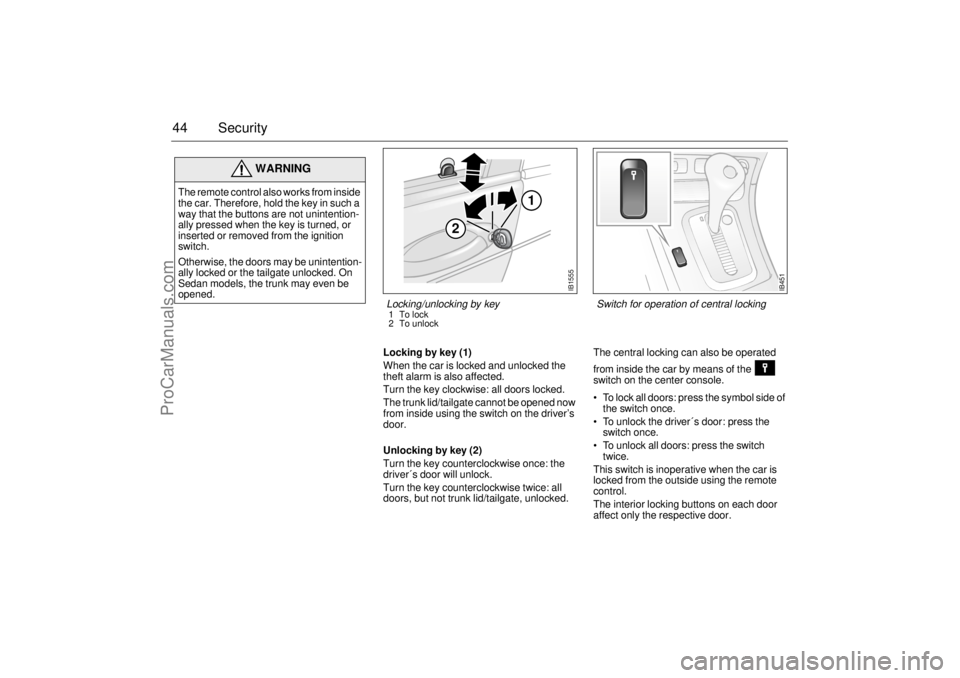
44 Security
Locking by key (1)
When the car is locked and unlocked the
theft alarm is also affected.
Turn the key clockwise: all doors locked.
The trunk lid/tailgate cannot be opened now
from inside using the switch on the driver’s
door.
Unlocking by key (2)
Turn the key counterclockwise once: the
driver´s door will unlock.
Turn the key counterclockwise twice: all
doors, but not trunk lid/tailgate, unlocked. The central locking can also be operated
from inside the car by means of the
switch on the center console.
To lock all doors: press the symbol side of
the switch once.
To unlock the driver´s door: press the
switch once.
To unlock all doors: press the switch
twice.
This switch is inoperative when the car is
locked from the outside using the remote
control.
The interior locking buttons on each door
affect only the respective door.
WARNING
The remote control also works from inside
the car. Therefore, hold the key in such a
way that the buttons are not unintention-
ally pressed when the key is turned, or
inserted or removed from the ignition
switch.
Otherwise, the doors may be unintention-
ally locked or the tailgate unlocked. On
Sedan models, the trunk may even be
opened.
IB451
Switch for operation of central locking
IB1555
2
1
Locking/unlocking by key1 To lock
2 To unlock
ProCarManuals.com
Page 47 of 288
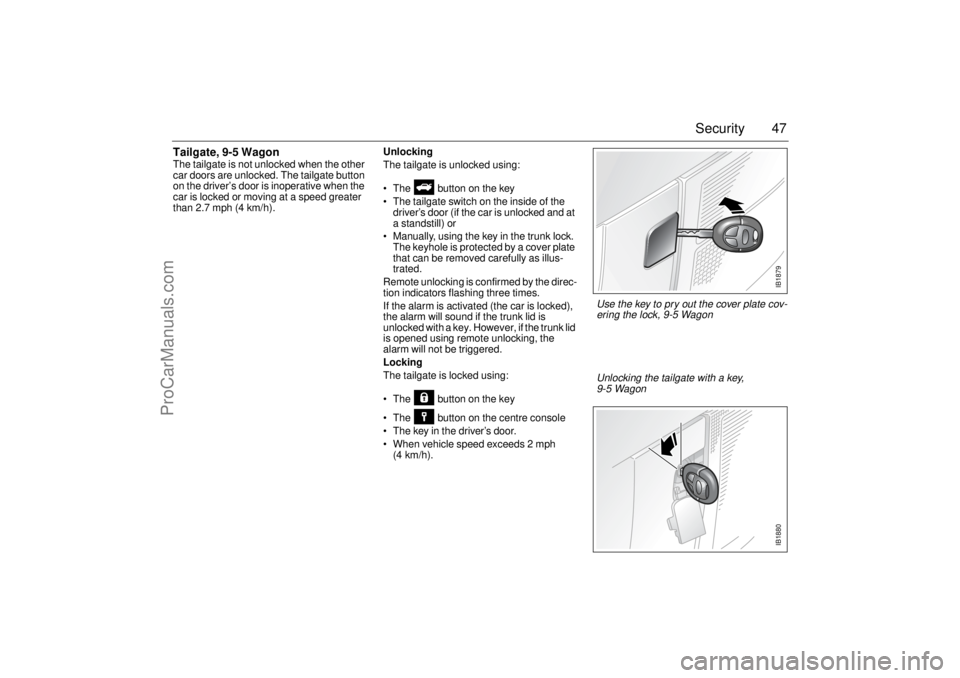
47 Security
Tailgate, 9-5 WagonThe tailgate is not unlocked when the other
car doors are unlocked. The tailgate button
on the driver’s door is inoperative when the
car is locked or moving at a speed greater
than 2.7 mph (4 km/h).Unlocking
The tailgate is unlocked using:
The button on the key
The tailgate switch on the inside of the
driver’s door (if the car is unlocked and at
a standstill) or
Manually, using the key in the trunk lock.
The keyhole is protected by a cover plate
that can be removed carefully as illus-
trated.
Remote unlocking is confirmed by the direc-
tion indicators flashing three times.
If the alarm is activated (the car is locked),
the alarm will sound if the trunk lid is
unlocked with a key. However, if the trunk lid
is opened using remote unlocking, the
alarm will not be triggered.
Locking
The tailgate is locked using:
The button on the key
The button on the centre console
The key in the driver’s door.
When vehicle speed exceeds 2 mph
(4 km/h).
IB1880IB1879
Unlocking the tailgate with a key,
9-5 Wagon Use the key to pry out the cover plate cov-
ering the lock, 9-5 Wagon
ProCarManuals.com
Page 48 of 288

48 SecurityCar alarm The car alarm (anti-theft system) is acti-
vated/deactivated when the car is
locked/unlocked by the remote control or by
the key, see page 43.
The antenna for the alarm system is located
in the center console.
All the doors plus trunk lid/tailgate and hood
are monitored by microswitches, and win-
dow-glass sensors will trigger the alarm if
any glass is broken. Your Saab 9-5 is equipped with an Elec-
tronic starting interlock (immobilizer), see
page 49 for details.
The car alarm is armed 10 seconds after the
car has been locked by the remote control.
During this ten-second delay period, the
doors, trunk lid/tailgate and hood may still
be opened without the alarm being trig-
gered.
The LED indicator on the instrument panel
fascia will be on continuously during this
period, at the end of which it will start to flash
(once every other second). If a door or the trunk lid/tailgate or hood has
been left open when the car is locked, the
LED on the fascia will flash (three times per
second) for ten seconds to indicate this.
Check to ensure that all the doors, plus
trunk lid/tailgate and hood, are closed prop-
erly.
If the fault persists (LED flashing when
renewed attempt made to activate the car
alarm by remote control), lock the car using
the key instead. The car alarm will not have
been activated and you should get in touch
with an authorized Saab dealer.
To avoid inconvenience caused by the
alarm being triggered inadvertently, make
sure that anyone else using the car is famil-
iar with how both the car alarm and the lock-
ing system work.
If the alarm is tripped (the direction indica-
tors are flashing and the siren is on) it can
be turned off by unlocking the car using the
button.
WARNING
Leaving children or pets unattended in a
locked car is dangerous. It is also danger-
ous to leave children in a vehicle with the
ignition key. A child or others could be
badly injured or even killed.
IB1524
3
2 1
Remote control 1 Activate/lock
2 Deactivate/unlock
3 Unlock trunk/tailgate
Unlocking the tailgate (9-5 Wagon)
ProCarManuals.com
Page 51 of 288

51 Security
Overview of functions
Alarm signals may differ between model variants for different coun-
tries.
Some of the car-alarm functions can be reprogrammed – con-
sult your Saab dealer for further details (see page 271). Locking/
activation Hazard warning lights flash once and the horn
chirps once.
The LED will come on for 10 seconds.
Unlocking/
deactivation Hazard warning lights flash twice and the horn
chirps twice.
The LED will come on for two seconds.
Unlocking/
deactivation of
trunk lid/tailgate
alarm Hazard warning lights flash three times and the
horn chirps three times.
The LED will flash three times per second for 10
seconds.
Alarm triggered Hazard warning lights flash for 5 min.
Siren wails for 30 seconds.
To switch off the alarm, deactivate the system in
the normal way (unlocking).
Window-glass
sensor The sensor detects if any window is broken and
triggers the alarm.
To disable the sensor, see page 49.
Key The range of the key is normally 5–10 yds. (5–
10 metres), although it can be substantially more
than this in ideal conditions (range can vary
greatly depending on the position of the car and
its surroundings).
If the key is not working, it may be because the
code signal has not been synchronized with that
in the control module for the car alarm. To rectify
this, press the unlock button on the key at least
four times in quick succession. When it is recog-
nized, the door locks will cycle.
If a key is lost, the new one will have to be pro-
grammed (all keys must be present) to match the
car’s unique security code. Contact an author-
ized Saab dealer.Battery for key The battery for the key will normally have a life of
4 years. When the battery needs changing,
”REPLACE KEY BATTERY” will appear on the
Saab Information Display (SID).
Contact an authorized Saab dealer.
Car-battery
voltage If the battery is disconnected while the alarm is
active (car is locked), for example during an
attempt to steal the car, the alarm will be trig-
gered.
ProCarManuals.com
Page 52 of 288

52 SecurityOverview of LED signals and SID messagesSome signals may differ between model variants for different
countries. Status LED signal
Activation (during 10-second delay). Comes on for 10 seconds.
Alarm activated (after delay). Flashes once every other
second.
Deactivation. Comes on for 2 seconds.
Alarm not activated. Off.
Door, trunk lid/tailgate or hood open
or opened during delay period.Flashes three times per sec-
ond for 10 seconds.
Unlocking the trunk lid/tailgate. Flashes three times per sec-
ond for 10 seconds.
Closing of door, trunk lid/tailgate or
hood after delay period.Comes on for 10 seconds.
Car immobilized but not locked.
Car alarm not activated.Flashes twice at three sec-
onds intervals.
Fault in a switch serving doors, hood
or trunk lid.Flashing (instead of being
on continuously) during
delay period.
SID message Reason/action
SERVICE THEFT ALARM Probably a fault in one of the sensors
or the alarm siren.
Have the car checked by an autho-
rized Saab dealer.
KEY NOT ACCEPTED Fault in key transmitter or in igni-
tion-switch receiver.
Turn ignition switch to ON and press
the unlock button on the key. Start
the engine.
Have the car checked by an autho-
rized Saab dealer.
REPLACE KEY BATTERY Fit a new battery in the key, see page
45.
DOOR ALARM ONLY Window-glass sensor disabled.
FULL THEFT ALARM Window-glass sensor in circuit.
REMOTE KEY
TRANSPONDRTurn the ignition key to position ON
and then press the button for open-
ing the trunk lid. Saab Information
Display (SID) displays the number of
keys and transmitters (transpon-
ders) coded to the car.
ProCarManuals.com
Page 60 of 288
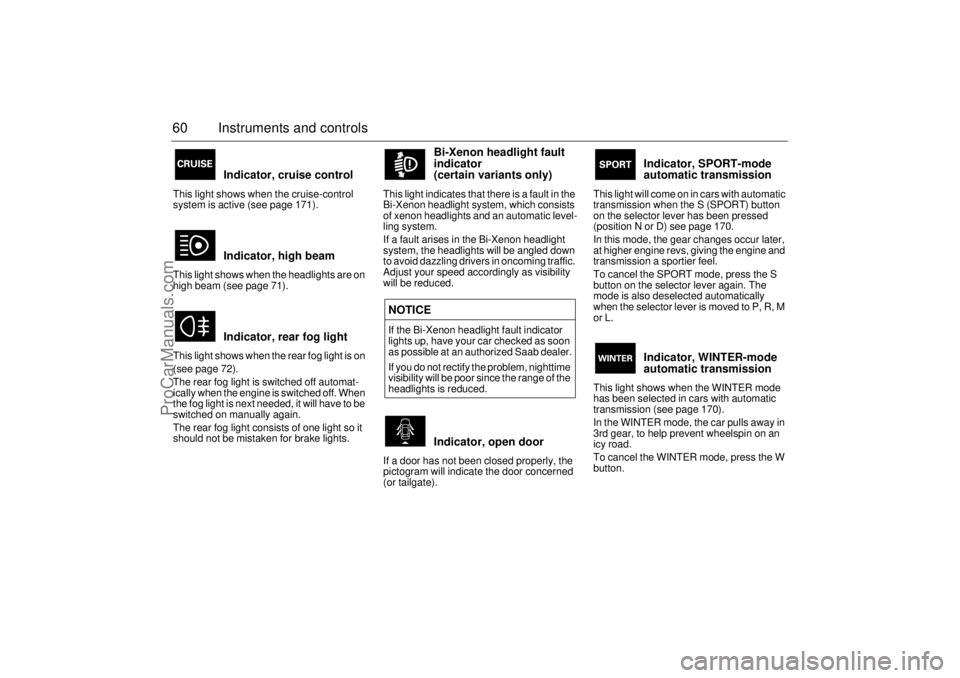
60 Instruments and controls
Indicator, cruise control
This light shows when the cruise-control
system is active (see page 171).
Indicator, high beam
This light shows when the headlights are on
high beam (see page 71).
Indicator, rear fog light
This light shows when the rear fog light is on
(see page 72).
The rear fog light is switched off automat-
ically when the engine is switched off. When
the fog light is next needed, it will have to be
switched on manually again.
The rear fog light consists of one light so it
should not be mistaken for brake lights.
Bi-Xenon headlight fault
indicator
(certain variants only)
This light indicates that there is a fault in the
Bi-Xenon headlight system, which consists
of xenon headlights and an automatic level-
ling system.
If a fault arises in the Bi-Xenon headlight
system, the headlights will be angled down
to avoid dazzling drivers in oncoming traffic.
Adjust your speed accordingly as visibility
will be reduced.
Indicator, open door
If a door has not been closed properly, the
pictogram will indicate the door concerned
(or tailgate).
Indicator, SPORT-mode
automatic transmission
This light will come on in cars with automatic
transmission when the S (SPORT) button
on the selector lever has been pressed
(position N or D) see page 170.
In this mode, the gear changes occur later,
at higher engine revs, giving the engine and
transmission a sportier feel.
To cancel the SPORT mode, press the S
button on the selector lever again. The
mode is also deselected automatically
w h e n t h e s e l e c t o r l e v e r i s m o v e d t o P , R , M
or L.
Indicator, WINTER-mode
automatic transmission
This light shows when the WINTER mode
has been selected in cars with automatic
transmission (see page 170).
In the WINTER mode, the car pulls away in
3rd gear, to help prevent wheelspin on an
icy road.
To cancel the WINTER mode, press the W
button.
NOTICEIf the Bi-Xenon headlight fault indicator
lights up, have your car checked as soon
as possible at an authorized Saab dealer.
If you do not rectify the problem, nighttime
visibility will be poor since the range of the
headlights is reduced.
ProCarManuals.com
Page 144 of 288
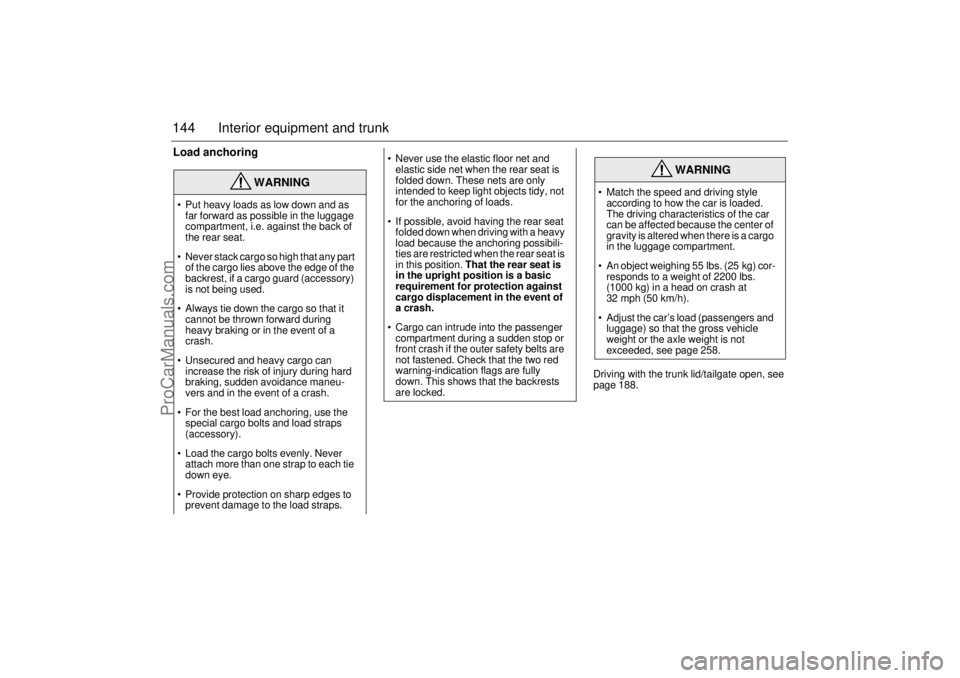
144 Interior equipment and trunkLoad anchoring
Driving with the trunk lid/tailgate open, see
page 188.
WARNING
Put heavy loads as low down and as
far forward as possible in the luggage
compartment, i.e. against the back of
the rear seat.
Never stack cargo so high that any part
of the cargo lies above the edge of the
backrest, if a cargo guard (accessory)
is not being used.
Always tie down the cargo so that it
cannot be thrown forward during
heavy braking or in the event of a
crash.
Unsecured and heavy cargo can
increase the risk of injury during hard
braking, sudden avoidance maneu-
vers and in the event of a crash.
For the best load anchoring, use the
special cargo bolts and load straps
(accessory).
Load the cargo bolts evenly. Never
attach more than one strap to each tie
down eye.
Provide protection on sharp edges to
prevent damage to the load straps.
Never use the elastic floor net and
elastic side net when the rear seat is
folded down. These nets are only
intended to keep light objects tidy, not
for the anchoring of loads.
If possible, avoid having the rear seat
folded down when driving with a heavy
load because the anchoring possibili-
ties are restricted when the rear seat is
in this position. That the rear seat is
in the upright position is a basic
requirement for protection against
cargo displacement in the event of
a crash.
Cargo can intrude into the passenger
compartment during a sudden stop or
front crash if the outer safety belts are
not fastened. Check that the two red
warning-indication flags are fully
down. This shows that the backrests
are locked.
WARNING
Match the speed and driving style
according to how the car is loaded.
The driving characteristics of the car
can be affected because the center of
gravity is altered when there is a cargo
in the luggage compartment.
An object weighing 55 lbs. (25 kg) cor-
responds to a weight of 2200 lbs.
(1000 kg) in a head on crash at
32 mph (50 km/h).
Adjust the car’s load (passengers and
luggage) so that the gross vehicle
weight or the axle weight is not
exceeded, see page 258.
ProCarManuals.com